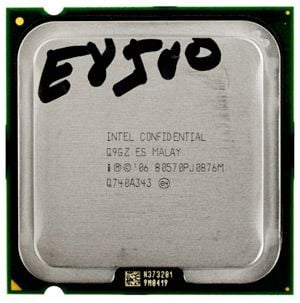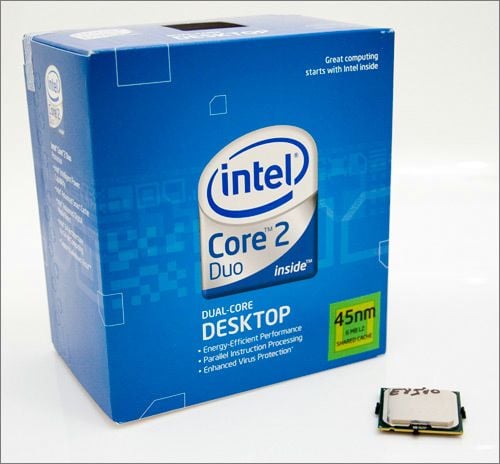Intel Core 2 Duo E8500 Wolfdale CPU
Overview and Specifications
 Intel fans have been patiently waiting for the company to release their lineup of refreshed Core 2 Duo and Quad products. Intel started hyping these revised components late last year, and they were expected to hit the market in January of this year. While Intel technically hit that date with the release of one 45nm component, it was the ultra-expensive Core 2 Extreme QX9650, which sells for over $1,000. Not really the type of component that everyone can get their hands on. Nevertheless, the current generation of 65nm Core 2 products continued to fall in price, and with no real competition from AMD’s Phenom X4 lineup, there really hasn’t been too much of a problem with Intel’s delays.
Intel fans have been patiently waiting for the company to release their lineup of refreshed Core 2 Duo and Quad products. Intel started hyping these revised components late last year, and they were expected to hit the market in January of this year. While Intel technically hit that date with the release of one 45nm component, it was the ultra-expensive Core 2 Extreme QX9650, which sells for over $1,000. Not really the type of component that everyone can get their hands on. Nevertheless, the current generation of 65nm Core 2 products continued to fall in price, and with no real competition from AMD’s Phenom X4 lineup, there really hasn’t been too much of a problem with Intel’s delays.
In the meantime, Intel has been producing 45nm components and building up inventory, and the first wave of them is getting ready to finally hit the market. Intel’s 45nm technology will allow for this new lineup of Core 2 processors to have significantly smaller dies, allowing Intel to put more cache onto the processor die, which in turn helps them to achieve higher performance. The new manufacturing technology also improves power consumption and heat production, and will allow Intel to scale the processors to higher clock speeds, finally allowing us to break through the 3.0 GHz wall which the industry has been stuck at for some time.
Intel’s new 45nm Core 2 processors are members of the “Penryn” family, which has two sub-codenames as well. Intel has “Yorkfield”, their 45nm Core 2 quad-core processor design, along with “Wolfdale”, their 45nm Core 2 dual-core processor design. Today we’ll be looking at the fastest member of Intel’s first wave of “Wolfdale” processors, which will officially be sold under the name “Core 2 Duo E8500”.
While this new lineup of Core 2 processors does not showcase a huge architectural change for Intel’s flagship processor lineup, we do see a host of smaller changes all coming together for a product lineup which is, in reality, one of the most exciting processor releases in some time. “Wolfdale” chips have been receiving much more buzz than expected, and early adopters who have received them have been thrilled with their flexibility, performance, and environmental attributes.
![]()
Intel Core 2 Duo E8500
Features & Specifications
|
 Core 2 Duo E8500 ES - Top |
 Core 2 Duo E8500 ES - Bottom |
The Core 2 Duo E8500 processor, as we’ve mentioned, is based on Intel’s new 45nm “Wolfdale” design. This new design brings some significant benefits to the table in comparison to the previous generation 65nm “Conroe” design. Let’s run through a few of them.
First off, clock speeds. The previous generation Core 2 Duo lineup clocked up to 3.0 GHz at its peak with the E6850, whereas this new line of Core 2 Duo processors is hitting 3.16 GHz with its first release. The E8500 runs at 3.16 GHz, whereas we will also have the E8400 (3.0 GHz), E8300 (2.83 GHz) and E8200 (2.66 GHz) on the market soon as well. These chips all run at 1333 MHz front side bus speed by default, a feature which was only seen on the later models of the older Core 2 lineup. Keep in mind; Intel likes to nudge up clock speeds over time, so we are fully expecting that these new Wolfdale chips will be launched at speeds at ~3.5 GHz in time – especially judging from the overclocking results which we’ll show later.
Secondly, the new “Wolfdale” design improves power consumption. Intel’s previous lineup had TDP (Thermal Design Power) levels of 75W when hitting clock speeds of 2.6 – 2.9 GHz, whereas the new Core 2 Duo E8500 processor has a TDP level of 65W when running at 3.16 GHz. Lower TDP levels mean it’s consuming less power from your outlet and producing less heat, which means power supplies and cooling systems don’t have to work quite as hard. It also helps overclockability, as well. The Core 2 Duo E8500 “Wolfdale” component runs at a 1.225V core voltage level, compared to 1.325V of the prior generation.
Thirdly, Intel has shrunk the size of the chip considerably. Previous generation dual-core processors were 143 mm2, whereas the new “Wolfdale” Core2 Duo processors are 107mm2 under the hood. This means Intel can make more of these chips per wafer, hopefully helping to drive down costs. So far, it seems to be working, as “Wolfdale” chips are actually selling for LESS compared to previous generation models at lower clock speeds. The smaller size also has let Intel up the amount of L2 cache on the processor die up to 6 MB per chip, compared to 4 MB with previous generation dual-cores. All applications can make benefit of additional cache, especially games, so this is definitely a good thing.
Intel has also thrown in the new SSE 4.1 instruction set with this new lineup as well, which helps with video encoding speeds especially. All of the other standard Core 2 goodies are there as well, like hardware virtualization acceleration, execute disable bit (xD), 64-bit processing support, and SSE-2/3 support. Not to mention, these new 45nm chips still run in the same Socket-775 form factor we’ve come to know and love throughout the past few years. Most newer motherboards which support 1333 MHz FSB will be compatible with this new lineup of Core 2 processors, although a large variety will need a BIOS update in order to support them fully. Every platform which we tested the chip on required a BIOS update of some sort in order to obtain full functionality. Luckily, all motherboards we tried already had BIOS releases out and readily available.







